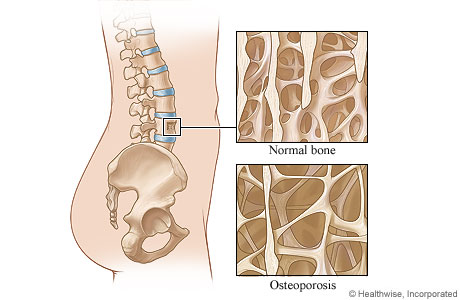Osteoporosis
What is osteoporosis?
Osteoporosis is a disease that affects your bones. It means that you have bones that are thin and brittle with lots of holes inside them like a sponge. This makes them easy to break. Osteoporosis can lead to broken bones (fractures) in the hip, spine, and wrist. These fractures can be disabling and may make it hard for you to live on your own.
Osteoporosis affects millions of older adults. It usually occurs after age 60. It's most common in women, but men can get it too.
Symptoms
Healthy Bone Versus Bone Weakened by Osteoporosis

Osteoporosis is a progressive disease that causes bones to become thin and porous, significantly increasing the risk for spinal and hip fractures. Osteoporosis usually does not have an effect on people until they are 60 or older.
What are the symptoms of osteoporosis?
In the early stages of osteoporosis, you probably won't have symptoms. As the disease progresses, you may have symptoms related to weakened bones, such as:
- Broken bones (fractures) that might occur with a minor injury, especially in the hip, spine, and wrist.
- Back pain.
- Loss of height and stooped posture.
- A curved upper back (dowager's hump). You might notice that you aren't as tall as you used to be.
- Compression fractures in the spine that may cause severe back pain. But sometimes these fractures cause only minor symptoms or no symptoms at all.
Diagnosis
How is osteoporosis diagnosed?
To diagnose osteoporosis, your doctor will ask about your symptoms and do a physical exam. You may also have a test that measures your bone strength (bone density test) and your risk for a broken bone.
During the physical exam, the doctor will:
- Measure your height and compare the results with past measurements.
- Examine your body for signs of previous broken bones, such as changes in the shape of your long bones and spine.
The bone density test helps your doctor estimate the strength of your bones. If the test finds that your bone thickness is less than normal but isn't osteoporosis, you may have low bone density (sometimes called osteopenia). It's a less severe type of bone thinning.
Routine urine and blood tests can rule out other medical conditions. These include hyperthyroidism and Cushing's syndrome. These conditions can cause bone loss.
Treatment
How is osteoporosis treated?
Treatment for osteoporosis focuses on reducing bone loss, building bone strength, and preventing broken bones. Treatment may include:
- Taking medicines that slow the rate of bone thinning and help build bone density.
- Getting enough calcium and vitamin D to build strong, healthy bones.
- Having healthy habits, such as getting plenty of weight-bearing exercise, eating healthy foods, and not smoking. This can help slow osteoporosis.
Making even small changes in how you eat and exercise, along with taking medicine, can help prevent a broken bone.
It's also important to protect yourself from falling. For example, you can reduce your risk of breaking a bone by making your home safer.
Copyrighted material adapted with permission from Healthwise, Incorporated. This information does not replace the advice of a doctor.
